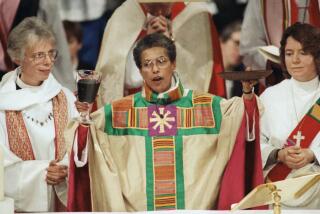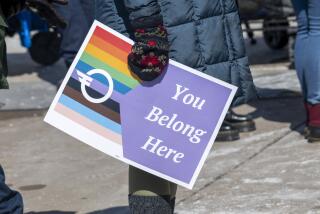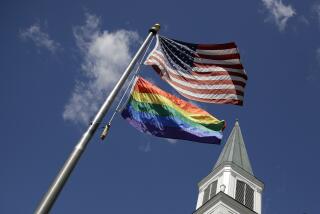Survey of Religious Trends Finds Many Changing Churches : Statistics: About one-fourth of active Christians have switched denominations at least once.
- Share via
NEW YORK — Jumping denominational borders has become a Christian habit, a sort of roundabout ecumenical blending process. Recent findings show a lot of it goes on nowadays.
About a fourth of present-day church members have switched denominations at least once, says the Princeton Religion Research Center.
It also reports these trends:
* A gradual increase to 58% in adults saying religion is “very important” to them, up from 53% in 1987. Another 29% term it “fairly important.”
* A “religion index,” a combined measurement of key attitudes and practices included to determine the overall vigor of religion in America, has halted a long-term decline and started edging upward.
* Christian religious affiliations no longer seem to have much bearing on whether people are Democrats or Republicans. Catholics are only slightly more likely to be Democrats and Protestants just slightly more likely to be Republicans.
* Biblical literalism--belief that the Bible is God’s actual, word-for-word composition, to be taken literally as fact--has declined steeply over the last 25 years.
It used to be the predominant view of Americans, held by 65% of them as recently as 1963. But now only 32% regard the Bible as coming verbatim from God.
Nevertheless, most still hold that the Bible conveys God’s inspired truth, although the prevalent view is that not all accounts should be interpreted literally.
These and other religious tendencies, determined by surveys by the Gallup organization, are summarized in recent issues of the research center’s Emerging Trends.
On the denomination-hopping phenomenon, a national sample of 1,002 adults surveyed in April found that 23% have switched denominations at least once.
The survey’s margin of error was plus or minus 3%.
Overall, the crisscrossing seems numerically to benefit Protestants, since 81% of those who switched ended up in Protestant churches, while only 9% moved into Roman Catholic churches.
Another 10% had become Eastern Orthodox, Mormon, Jewish or moved to one of many movements that do not fit into the typical categories.
Among Protestants, the smaller, more conservative groups were the most likely to receive those who switched, followed by Methodists, Southern Baptists and Presbyterians.
The main reason given for changing denominations was marriage, with 24% of the switches made to match the religious affiliation of a mate.
Among other reasons, 14% cited preference for another denomination, 10% cited influence by friends, relatives or children, and 7% said they found perspectives of former denominations lacking. Five percent said a moving “religious experience” caused them to switch.
The center’s “religious index,” based on measurements of eight religious factors in society, was found to have risen slightly over the last three years, to 656.
The highest possible reading is 1,000, a level unlikely to be reached because it would require full commitment to God by everyone. Its peak of the index in the Gallup organization’s 50 years of taking the American religious pulse was 745 in 1960.
It declined through the social upheavals of the 1960s and 1970s and televangelist scandals of the 1980s, hitting a low of 651 in 1989 and 1990.
Among the categories considered in the index are belief in God, always high and ranging from 94% to 99% over the last five decades, and the percentage with a religious preference, which has been steady around 90%.
However, other factors have ranged widely, such as faith in the ability of religion to answer today’s problems, active denominational membership, confidence in “organized religion,” the percentage of respondents considering religion very important, and regularity of worship attendance.
More to Read
Sign up for Essential California
The most important California stories and recommendations in your inbox every morning.
You may occasionally receive promotional content from the Los Angeles Times.













